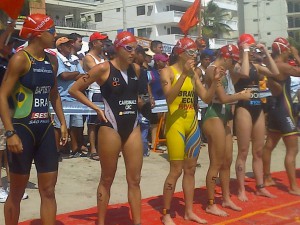By Raquel Tavares-Torres, Professional Tri-athlete
Last year, I had my first Elite experience (ITU draft legal race) in Sarasota, Florida. In hindsight, I have to laugh at myself. What was I thinking? To race at that level with just a few weeks of “training,” especially after more than 12 years without riding a bike or doing anything remotely similar to triathlons, didn’t seem like a great decision.
While we were packing the bike Coach Mark Olson let me borrow (I didn’t even have my own bike!), I told him I was apprehensive and nervous about racing at the elite level; when I decided to try the triathlon, it was just for fun, as more of a personal challenge. I didn’t know that weeks later I’d be flying to Florida to compete.
I can still hear him saying to me, “Raquel, just go and have fun. Go there and learn.”
So, basically, that’s what I did. I flew to Florida, with minimal experience, without enough training, without the right equipment and by myself! I might have been apprehensive and I might have been a bit scared, but it was one of the best things I’ve ever done because of what I learned.
When I arrived in Florida, I didn’t have a wet suit. I had to borrow one from another coach and one of his junior athletes. One hour before the race, I squeezed myself into a super tight wetsuit. During the race, I felt as if I was swimming in a straitjacket. As a result, I was out of the water a full 3 minutes after the first group. 3 minutes is a long time in an Elite race, in any race really. Racers who are fast out of the water are able to, as mentioned above, join the peloton, conserve energy, race faster, and race with the lead pack. Those of us left behind in the water must face the head winds alone as we struggle to catch up. Catching up, at this point, is difficult, and unlikely.
A race official dressed all in black, riding a huge motorcycle, pulled me over and said, brusquely, “Give me your chip” (referring to my timing chip with which I would be scored).
I’d been lapped. Once you’re lapped, your race is over. I looked over and saw a few of the other women on the ground, next to their bikes, tears streaming down their faces, and felt my own tears well up in my eyes. We’d all been lapped. Our races were done.
So what did I learn?
– In draft legal races, you can “cheat” or you can work. If you are in a big group of good riders and you draft, you avoid the head wind and expend approximately 30% less effort than the people who are working in the front of the group or peloton. You want to be with the pack. You want to conserve energy.
-In Elite racing, every part of the race is important. A good, fast swim means you get to ride with the fast riders and draft with them as well.
-Bad races happen, even to experienced athletes who have trained. Sometimes it’s a bad swim, sometimes you get out of the water and your legs are spent. There are a variety of factors, often beyond your control, that can influence your race, and if just one of them is off, it can set off a chain reaction. What matters is that you know it can happen to anyone. Even elite athletes have bad races. Even elite athletes get lapped, and it happens quite often.
More importantly, what matters most is that you look at every racing opportunity as a chance to learn whether the outcome is what you expect or not. The true measure of my success is my ability to walk away from a bad race and use what I learned to my advantage in my next race. This is how you get better. We do not learn to walk on day one, first we must fall, and from falling we learn balance. The triathlon is no different. It is about balance. It is about learning. In order to do this, we first must get out there.










